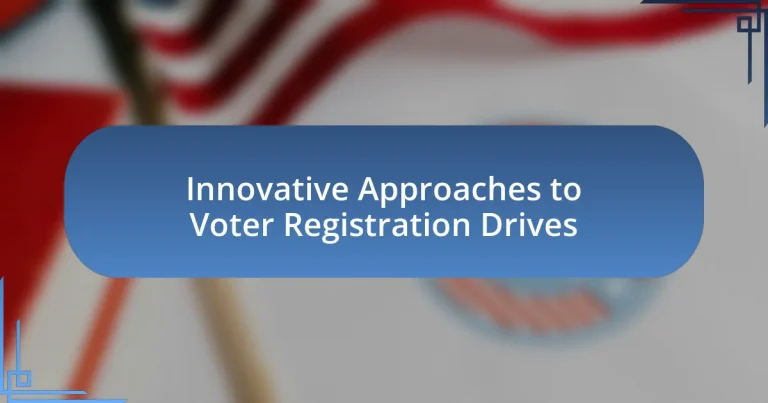Innovative approaches to voter registration drives leverage technology and community engagement to enhance accessibility and participation among diverse populations. Key strategies include online registration platforms, mobile applications, and targeted outreach efforts that focus on underrepresented groups. Research indicates that these methods can significantly increase registration rates, with states like California and Colorado reporting substantial gains since implementing online systems. Additionally, community-based initiatives foster trust and encourage voter engagement, demonstrating the effectiveness of combining technology with localized efforts to address barriers in traditional voter registration methods.

What are Innovative Approaches to Voter Registration Drives?
Innovative approaches to voter registration drives include the use of technology, such as online registration platforms and mobile apps, which streamline the registration process and increase accessibility. For instance, states like California and Colorado have implemented online voter registration systems that have significantly boosted registration numbers; California reported over 1.5 million new registrations since its launch in 2012. Additionally, community engagement strategies, such as partnerships with local organizations and events, have proven effective in reaching underrepresented populations. Research from the Brennan Center for Justice indicates that targeted outreach efforts can increase registration rates by up to 20% in specific demographics. These methods demonstrate how leveraging technology and community involvement can enhance voter registration efforts.
How do these approaches differ from traditional voter registration methods?
Innovative approaches to voter registration differ from traditional methods primarily in their use of technology and outreach strategies. Traditional voter registration often relies on paper forms and in-person visits to designated offices, which can create barriers for potential voters. In contrast, innovative methods utilize online platforms, mobile applications, and social media campaigns to streamline the registration process, making it more accessible and user-friendly. For example, states that have implemented online voter registration have seen increased registration rates; Arizona reported a 44% increase in registrations after adopting this method. Additionally, innovative approaches often focus on targeted outreach to underrepresented communities, employing data analytics to identify and engage potential voters more effectively than traditional methods, which may not prioritize such demographic insights.
What are the key characteristics of innovative voter registration drives?
Innovative voter registration drives are characterized by their use of technology, community engagement, accessibility, and targeted outreach. These drives often leverage digital platforms, such as online registration tools and social media campaigns, to reach a broader audience and simplify the registration process. For instance, the National Voter Registration Act of 1993 allowed states to offer online registration, significantly increasing participation rates. Additionally, successful drives prioritize inclusivity by addressing barriers faced by underrepresented groups, such as language assistance and mobile registration units in underserved areas. Research shows that community-based initiatives, like partnerships with local organizations, enhance trust and encourage participation, leading to higher registration numbers.
How do technology and social media play a role in these innovations?
Technology and social media significantly enhance voter registration drives by streamlining processes and increasing outreach. Digital platforms allow organizations to create user-friendly online registration forms, making it easier for individuals to register from their devices. For instance, the National Voter Registration Act of 1993 enabled states to offer online registration, which has led to a substantial increase in registered voters; as of 2020, 40 states and the District of Columbia provide online voter registration. Social media amplifies these efforts by enabling targeted campaigns that reach specific demographics, facilitating engagement through shares and likes, and providing real-time updates on registration deadlines and voting information. Research from the Pew Research Center indicates that 69% of adults use social media, making it a powerful tool for mobilizing voters and disseminating information quickly and effectively.
Why are innovative approaches necessary for voter registration?
Innovative approaches are necessary for voter registration to enhance accessibility and engagement among diverse populations. Traditional methods often fail to reach underrepresented groups, leading to lower participation rates. For instance, the U.S. Census Bureau reported that in the 2020 election, only 50% of eligible voters aged 18-29 participated, highlighting the need for strategies that resonate with younger demographics. Implementing technology-driven solutions, such as online registration and mobile apps, can streamline the process and attract more voters. Additionally, community-based initiatives that leverage social media and local influencers have proven effective in increasing awareness and motivation to register, as evidenced by successful campaigns in various states that saw registration spikes following targeted outreach efforts.
What challenges do traditional voter registration methods face?
Traditional voter registration methods face significant challenges, including accessibility issues, bureaucratic inefficiencies, and low participation rates. Accessibility issues arise as many eligible voters, particularly those in marginalized communities, struggle to navigate complex registration processes or lack access to registration locations. Bureaucratic inefficiencies are evident in the lengthy processing times and outdated systems that can lead to errors and delays in voter registration. Additionally, low participation rates are a persistent problem, with studies indicating that approximately 50% of eligible voters do not register, often due to a lack of awareness or motivation. These challenges hinder the effectiveness of traditional voter registration methods and highlight the need for innovative solutions.
How can innovative approaches address these challenges?
Innovative approaches can address challenges in voter registration drives by utilizing technology and data analytics to streamline the registration process. For instance, mobile applications and online platforms can simplify access to registration, allowing users to register quickly and efficiently from their devices. Research from the Pew Charitable Trusts indicates that states implementing online voter registration saw a 20% increase in registration rates. Additionally, targeted outreach using data analytics can identify underrepresented populations, ensuring that efforts are focused where they are most needed, thereby increasing overall participation.
What impact do innovative voter registration drives have on voter turnout?
Innovative voter registration drives significantly increase voter turnout by making the registration process more accessible and engaging. For instance, initiatives that utilize technology, such as online registration and mobile apps, have been shown to streamline the process, leading to higher registration rates. A study by the Pew Research Center found that states implementing online voter registration saw an increase in registration by 10-20%. Additionally, community-based drives that incorporate social events or partnerships with local organizations foster a sense of community involvement, which further motivates individuals to participate in elections. These innovative approaches not only simplify registration but also create a more inclusive environment, ultimately enhancing voter turnout.
How do these approaches engage underrepresented populations?
Innovative approaches to voter registration drives engage underrepresented populations by utilizing targeted outreach strategies that address specific barriers these groups face. For instance, mobile registration units and community-based events are designed to reach individuals in low-income neighborhoods, where traditional registration methods may be less effective. Research indicates that these methods can increase registration rates among minorities and young voters; for example, a study by the U.S. Census Bureau found that states implementing same-day registration saw a 10% increase in voter turnout among underrepresented demographics. Additionally, partnerships with local organizations help build trust and provide culturally relevant information, further enhancing engagement.
What evidence supports the effectiveness of innovative voter registration strategies?
Innovative voter registration strategies have been shown to significantly increase voter participation rates. For instance, a study by the National Bureau of Economic Research found that automatic voter registration in states like California led to a 10% increase in voter registration rates. Additionally, online voter registration has been linked to higher registration numbers, with a report from the Pew Charitable Trusts indicating that states implementing online systems saw a 20% rise in registrations compared to those without. These findings demonstrate that innovative approaches effectively enhance voter registration and engagement.
How can organizations implement innovative voter registration drives?
Organizations can implement innovative voter registration drives by utilizing technology, community engagement, and targeted outreach strategies. For instance, leveraging mobile apps and online platforms can streamline the registration process, making it more accessible to younger voters; according to the U.S. Census Bureau, states with online registration saw a 10% increase in voter registration rates. Additionally, partnering with local businesses and community organizations can enhance visibility and trust, as evidenced by successful initiatives in cities like San Francisco, where collaborations led to a 15% increase in registrations among underrepresented populations. Finally, employing data analytics to identify and target specific demographics can optimize outreach efforts, ensuring that resources are effectively allocated to areas with lower registration rates.
What are some successful examples of innovative voter registration initiatives?
Successful examples of innovative voter registration initiatives include the National Voter Registration Act of 1993, which allowed individuals to register to vote while applying for or renewing a driver’s license, significantly increasing registration rates. Another example is the use of online voter registration, implemented in states like California, which saw a 25% increase in registrations after its launch in 2012. Additionally, organizations like Rock the Vote have utilized social media campaigns to engage younger voters, resulting in a 20% increase in voter turnout among millennials in the 2018 midterm elections. These initiatives demonstrate effective strategies that have led to increased voter registration and participation.
What lessons can be learned from these successful initiatives?
Successful initiatives in voter registration drives demonstrate the importance of targeted outreach, community engagement, and the use of technology. Targeted outreach ensures that efforts are directed towards underrepresented populations, increasing participation rates. For example, initiatives that focus on young voters or minority communities have shown significant increases in registration numbers. Community engagement fosters trust and encourages individuals to participate in the electoral process, as seen in programs that partner with local organizations. The use of technology, such as online registration and mobile apps, streamlines the process and makes it more accessible, evidenced by states that have implemented these tools reporting higher registration rates. These lessons highlight the effectiveness of a multifaceted approach in enhancing voter registration.
How can these lessons be applied to future voter registration efforts?
Lessons from past voter registration efforts can be applied to future initiatives by implementing targeted outreach strategies that address specific demographics. For instance, data from the U.S. Census Bureau indicates that younger voters and minority groups often have lower registration rates; thus, tailored campaigns using social media platforms popular among these demographics can enhance engagement. Additionally, simplifying the registration process through online platforms and automatic registration systems, as seen in states like California, has proven effective in increasing participation rates. These approaches demonstrate that understanding the audience and leveraging technology can significantly improve voter registration outcomes.
What best practices should organizations follow for effective voter registration drives?
Organizations should implement targeted outreach strategies for effective voter registration drives. This involves identifying specific demographics and communities that may be underrepresented in the electoral process, such as young voters, minorities, and low-income individuals. Research indicates that personalized communication, such as door-to-door canvassing and community events, significantly increases registration rates. For instance, a study by the National Bureau of Economic Research found that targeted mailings and in-person outreach can boost registration by up to 10%. Additionally, organizations should utilize technology, such as online registration platforms and social media campaigns, to streamline the registration process and engage younger voters. Data from the U.S. Census Bureau shows that online registration has led to higher participation rates among millennials and Gen Z. Lastly, providing clear information about the registration process and deadlines is crucial, as confusion can deter potential voters.


